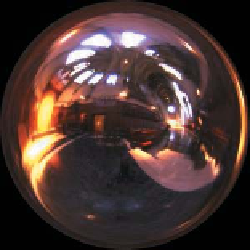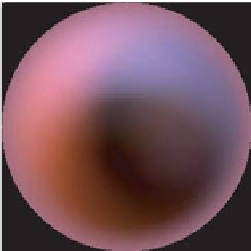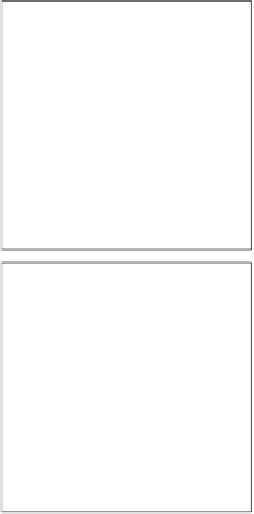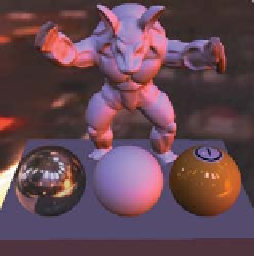Graphics Reference
In-Depth Information
As an extreme example, for a diffuse surface the only characteristic of the
arriving light that matters is irradiance—the cosine-weighted average radiance
over the visible hemisphere [RH01]. From an environment map, one can compute
the average for every possible direction, and use this
irradiance map
to rapidly
compute light reflected from a diffuse surface, assuming that the light arrives from
far enough away that the irradiance is a function of direction only. Figure 20.11
shows such an irradiance map, and Figure 20.12 shows a figure illuminated by it.
Inline Exercise 20.3:
Describe the appearance of a pure-white, totally diffuse
sphere, illuminated by the irradiance map of Figure 20.12, rendered with a
parallel projection in the same direction as the view shown for the irradiance
map. The answer is
not
that it looks exactly like the irradiance map!
Now that we've described the general idea of texture mapping (assigning texture
coordinates to object points, followed by evaluating functions on these coordi-
nates, often by interpolation of image values), let's look at a range of applications.
Table 20.1 presents these, listing for each application the property that is being
mapped, the map being used, and the name of the resultant technique. We use the
name “UV” to indicate some kind of surface parameterization.
Figure 20.11: Top: A sphere map
of light arriving at one point
in Grace Cathedral (Photograph
used with permission. Copyright
2012 University of Southern Cal-
ifornia, Institute for Creative
Technologies.) Bottom: An irra-
diance map formed from that
sphere map (Courtesy of Ravi
Ramamoorthi and Pat Hanrahan,
© 2001 ACM, Inc. Reprinted by
permission.)
and Reconstruction
When we render a scene in which there is texture mapping, no matter how simple
or complex the mapping scheme is, problems with sampling and aliasing can arise.
Table 20.1: Mapping applications.
Property
Map
Technique
k
d
,diffuse
reflectivity
UV
Diffuse detail mapping, like the
upholstery pattern on a sofa
k
s
, glossy
reflectivity
UV
Glossy detail, like the part of a
tarnished doorknob that's polished
by constant use
L
in
Reflection
Environment mapping
L
out
UV
Light mapping.
Texture mapping is
used to specify the emissivity
(typically diffuse) of an object like
a neon lamp.
Figure 20.12: Several objects
illuminated by the irradiance
map, represented in a compact
approximation (Courtesy of Ravi
Ramamoorthi and Pat Hanrahan,
© 2001 ACM, Inc. Reprinted by
permission.)
Position or
normal vector
UV
Bump mapping or displacement
mapping
Visibility of
a light source
Perspective
projection
Shadow mapping
(see Chapter 15)
Artistic
L
out
Various dot
products
XToon shading in expressive
rendering (see Section 33.8)










